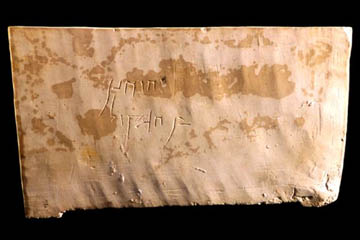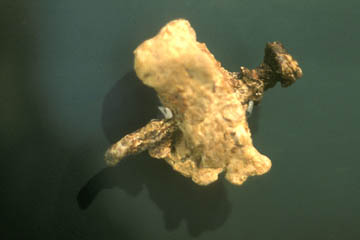Valuable nail
This weekend Christians around the world are celebrating the Easter story of the death and resurrection of Jesus Christ, so perhaps it would be appropriate to look at the archaeological evidence associated with this story. Of course, it is impossible to "prove" the story and we shall not even attempt anything so foolish. That is not to say that the story is false, merely that by its nature the story would leave no traces that could be distinguished by the archaeologist.
The first aspect is that of the crucifixion itself: surprisingly, although Josephus speaks of thousands being crucified around Jerusalem and there were doubtless hundreds if not thousands of other crucifixions during the Roman occupation of Palestine, only one crucified body has been identified - that of Yohanan ben Hagkol.

|
| The ossuary of Yohanan ben Hagkol with his name on the side. |
In 1968 archaeologist Vassilios Tzaferias was excavating a family tomb at Giva'at ha Mitvar in northern Jerusalem in which he eventually uncovered 35 bodies. Nine of the skeletons showed signs of a violent end, others bore indications that the people had died of starvation. When Tzaferias examined the ossuary that contained ben Hagkol's fragmentary skeleton, he was astonished to discover the rusted remains of a nail driven through one of the bones of the foot.
There is a very good reason why crucified bodies are hard to identify: iron was valuable and no one would bury the nails with the body - quite apart from harrowing the feelings of the relatives - when they could be removed and either sold, reused as nails or the iron fashioned into something else. It would appear that the unfortunate Yohanan was nailed to a cross that had a knot in it and the soft iron of the nail tip bent, in effect clenching the nail. When the body was removed from the cross it proved impossible to withdraw the nail and he was actually buried with a piece of wood still nailed to his foot!
Actually, Yohanan poses a particular problem for those who wish to meditate on the crucifixion of Christ. The crucifixes to be seen in many churches, as well as the many paintings of the crucifixion, all depict Jesus with nails through the palms of His hands and through the top of His feet. It has long been known that this was anatomically impossible, as the flesh of the hand is too weak to support the weight of a body and the nails would simply have ripped through the flesh. It is almost certain that Jesus' arms were fastened to the cross with nails through the wrist where there was sufficient bone and muscle to ensure that the nails did not pull through.

|
| The anklebone of Yohanan ben Hagkol with the nail still visible. |
However until ben Hagkol was discovered no one doubted that the feet were nailed as portrayed; the unfortunate Yohanan, however, had the nail driven in through the side of his foot and the exhibit in the Rockerfeller Museum in Israel depicts him either with his legs bent underneath him and twisted round to be nailed to the front of the cross, or spread awkwardly to allow a foot to be nailed on either side of the cross.
The main reason why crucifixion victims are hard to identify, however, is that not many of them were nailed to their crosses. It was quite sufficient to simply tie their arms and legs and leave them to die of exposure. Probably Jesus was nailed to His cross because of the charge against Him - "Jesus of Nazareth, King of the Jews" - and to frustrate any attempt at a rescue. It is one thing for a mob of would-be rescuers to cut through ropes holding the victim to the cross and quite another to pull out well-hammered nails - particularly if they have hit a knot!
According to the Biblical account, Jesus was taken down from the cross once His death had been established by the brutally simple but efficient way of stabbing Him through the heart with a spear. His body was then handed over to a rich man who had been a secret follower for some time. Some sceptics have protested that, quite apart from the unlikelihood of a rich man jeoparding his position in society by identifying with a condemned criminal, the Romans are unlikely to have allowed a decent burial to the body of a condemned criminal. I recently came across an interesting comment by Philo, the Jew from Alexandria.
I have known instances before now of men who had been crucified when this festival and holiday was at hand, being taken down and given up to their relations, in order to receive the honours of burial, and to enjoy such observances as are due to the dead. For it used to be considered, that even the dead ought to derive some enjoyment from the natal festival of a good emperor, and also that the sacred character of the festival ought to be regarded.
Philo, In Flaccum
I am not sure which festival he is talking about - probably the Emperor's birthday - but at least it is evidence that crucified criminals were not always thrown onto a rubbish dump to be devoured by dogs.
Having been buried - in haste because of the approaching Sabbath - Jesus remained in the tomb until Sunday morning. A group of His female followers returned to the tomb early that morning in order to complete the process of anointing the body. This was not embalming, as is commonly claimed.
In the first century AD the Jews developed the custom of burying the dead in a stone-cut tomb off whose central chamber a number of kokhim or tunnels the size of a coffin were dug. The body was placed in one of these kokhim and left for a year or more, by which time nothing was left except bones, which were then gathered and placed in an ossuary for permanent storage. Obviously embalming would hinder this process of decay and delay the transfer to an ossuary.
This is why archaeologists dismiss the claims of the Garden Tomb, for it does not have kokhim and is more typical of a tomb from the 6th century BC. While it is not impossible that Joseph of Arimathea might have chosen to have an old-fashioned tomb, it is rather unlikely.
As the women approached the tomb they discussed anxiously who should roll away the stone which covered the entrance. Many tombs of this period have finely cut disks of stone which roll like a wheel in front of the entrance to the tomb - the tomb of Herod's family and the so-called "Tombs of the Kings" are of this type.
When I first visited Jerusalem in 1958 I experimented with the stone in front of the doorway to the Tombs of the Kings and although only 9 years old, managed to roll it across the doorway without difficulty. (My parents, who were inside the tomb, were rather less impressed!) A couple of able-bodied women should have had no difficulty about moving such a stone.
The fact that they were worried probably indicates that this was not a wheel-like stone, but more like a rough boulder rolled against the entrance to the tomb, which would require considerable effort to shift. This is a far more likely scenario: the two tombs mentioned which had wheel-like stones were part of a larger complex of funerary buildings and any tomb robber would have to pass locked doors and possibly even guards.
Such precautions were beyond the reach of any except royalty, so a rough boulder or even a block of stone which would in itself form an obstacle to any tomb robber is both more natural and more likely as the method by which the tomb was closed.
Finally, although it is impossible even to conceive of what archaeological evidence might support the Christian belief in a resurrection, there is one curious fact which deserves consideration.
The Lament of Abba Saul preserves a tradition that the high priest and his family were tough cookies who were not averse to using violence when it suited their ends:
Woe is me because of the House of Annas
Woe is me because of their whisperings ...
For they are the high priests
Their sons are the treasurers
Their sons-in-law are temple officers
And their servants beat the people with rods.
Joseph records that the high priest was so greedy for money that he demanded - and enforced - the payment of all tithes into the temple treasury instead of to the individual priests, with the result that a number of these priests died of starvation!
The curious thing is that when he was confronted with the claim that Jesus had risen from the dead, no one in the high priest's family took action in the matter. The disciples were threatened and even beaten, but why were they not arrested for theft of a body or conspiracy or any one of a number of charges which could have been dreamed up by ingenious rogues like Annas and Caiaphas?
The whole Christian message could have been killed at birth by simply producing the body of Christ as evidence that He had not, in fact, risen from the dead. Why were the disciples, the most likely suspects, not arrested and tortured until they led the authorities to the hidden body? Even if they remained obdurate and refused to disclose where they had concealed the body, the death by torture of the men who were stirring up the whole city would have been almost as satisfactory to the House of Annas as finding the body - yet they were allowed to carry on preaching more or less free from interference.
Even a sceptic must admit that this is a curious circumstance, and while it falls far short of proof, it is nevertheless evidence that something was going on in Jerusalem. While many explanations might be possible, the resurrection of Jesus, however improbable, is the only historical explanation we are offered.
© Kendall K. Down 2009





